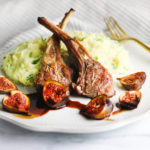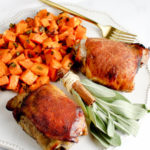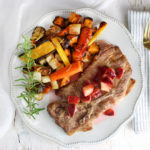 The Paleo Autoimmune Protocol (also referred to as AIP) is a specific version of the Paleo diet with special adaptations made to address autoimmune conditions. It is a powerful healing tool designed to reduce chronic inflammation in the body, restore a healthy digestive tract, and regulate the immune system.
The Paleo Autoimmune Protocol (also referred to as AIP) is a specific version of the Paleo diet with special adaptations made to address autoimmune conditions. It is a powerful healing tool designed to reduce chronic inflammation in the body, restore a healthy digestive tract, and regulate the immune system.
Your body has an amazing ability to heal itself when given the proper resources and the opportunity to do so. The basic principles of the Paleo Autoimmune Protocol rest on that theory. AIP stresses that by eating a real food diet and focusing on nutrient density, you can set the stage for healing to occur and reverse the effects of autoimmune disease.
In a nutshell, autoimmune disease is caused by the immune system mistakenly attacking your own body and organs rather than protecting them. For example, in the case of Hashimoto’s Thyroiditis, the immune system attacks the thyroid. The presence of gut dysbiosis (having the wrong kind or wrong number of bacteria in the gut) and a leaky gut (increased intestinal permeability) are almost always involved with autoimmune disease. The good news is we can help our gut and regulate our immune system with an appropriate diet and a few basic lifestyle changes.
The Paleo Autoimmune Protocol can be divided into 3 phases:
1 . the elimination phase,
2 . the reintroduction phase, and
3 . the maintenance phase.
1. the elimination phase:
The elimination phase contains a double-edged approach:
1) Remove all potential trigger foods that create chronic harmful inflammation and irritate the gut.
2) Add nutrient-dense foods to provide the body with the building blocks needed to repair and heal the gut.
Remove grains (and gluten), legumes (including soy and peanuts), dairy, eggs, nightshades, nuts and seeds (including coffee and cocoa), alcohol, food chemicals and additives, and refined and processed foods (like white sugar).
Some people embrace AIP and eliminate these inflammatory foods all at once. Others prefer a more progressive approach. Whether you dive in headfirst or slowly dip your toes in, your commitment to the Paleo Autoimmune Protocol is paramount. There is no 70/30 or 80/20 on AIP. You need to commit fully to this healing phase in order to see improvements.
Add nutrient-dense foods like grass-fed meats, organ meats, wild-caught seafood, a wide variety of both green and colorful vegetables, fruit, healthy fats, fermented foods, and bone broth.
AIP isn’t about finding rare, exotic ingredients. It is about going back to the basics—to simple, real ingredients that will promote health instead of creating inflammation. In truth, the Paleo Autoimmune Protocol is a very simple, healing diet that you will truly relish. Click here to access all the AIP recipes I have posted on my blog. For even more inspiration, check out my cookbook Simple French Paleo, packed with useful information, yes and no foods lists, and an entire collection of tasty recipes deeply rooted in French tradition!
Guidelines for a Happy Gut:
Eat between 8 to 14 cups of vegetables per day (measured raw)
Eat a wide variety of colorful fruit and vegetables
Choose seasonal fruits and vegetables
Choose organic grass-fed meats, organ meats, and wild-caught seafood
Consume healthy fats at every meal
Consume fermented foods and drinks
Consume bone broth
2. the reintroduction phase:
In this phase, you get to bring foods back into your daily diet that you had previously eliminated. The final result of the reintroduction process is different for everyone and will depend on your own food sensibilities.
Everyone will require a minimum of 30 days in the elimination phase, although it is better to wait three to four months. Some people, often those who are severely ill and require a great deal of healing, wait a full year. The longer you wait, the better chance your body has to heal and prepare for new foods. Resist the temptation to rush the reintroductions to satisfy your cravings. Take the time to heal. It will be worth the wait!
The basic procedure for reintroducing foods involves eating the chosen new food several times throughout the day and monitoring your body for symptoms. Introduce new foods one at a time and do not rush. (If you notice symptoms at any time during the process, stop eating the newly introduced food immediately and try again after your symptoms resolve completely.)
1. Choose one food to reintroduce.
2 . Eat one half teaspoon and wait for 15 minutes.
3 . If no symptoms appear, eat one teaspoon and wait for another 15 minutes.
4 . If no symptoms appear, eat one and one half teaspoons and wait two to three hours.
5 . If you still have no reaction, eat a normal-size portion, then wait three days before eating it again.
Monitor yourself closely for symptoms. A reaction will usually appear within one to four hours after eating the food, but may take up to three days. Symptoms will vary from person to person and can be either mild or acute. They usually will exacerbate your autoimmune disease symptoms. Symptoms can include digestive troubles, mood swings, reduced energy, unusual food cravings, sleep disturbances, hives, headaches, skin reaction, joint pain, and brain fog, among others.
For more information on how to reintroduce foods and in which order, read this post or check out the step-by-step guide to Reintroducing Foods on the Paleo AIP by Eileen Laird.
3. the maintenance phase:
The process of the reintroduction phase of the Paleo Autoimmune Protocol (also referred to as AIP) will help you discover which foods benefit your body and which foods trigger inflammation and autoimmune flares. The maintenance phase is where you hold it all together. At this point, your diet will most likely look like a cross between strict AIP and a standard paleo/primal diet. This will be your maintenance diet. You are a unique snowflake and your diet will reflect that from here on out!
Know that the foods you tolerate may vary over time. A food that you have reintroduced successfully in the past might become problematic again in the future, especially if your “balance” is compromised (increased stress, poor sleep, infections, etc.). For this reason, it is important to be vigilant and keep an eye out for sneaky, slow-moving symptoms. Be ready to exclude any trigger foods from your diet should you notice any symptoms creeping in—at least for a while.
As a general rule, anytime you experience a resurgence of old autoimmune symptoms or the presentation of new ones, it is a good idea to retreat to the elimination phase for a period, until your symptoms have completely resolved.
As you get on with your life and start to experiment with new foods, keep the basic principles of the Paleo Autoimmune Protocol top of mind:
- prioritize nutrient density,
- eat a wide variety of health-promoting foods, and
- keep your gut healthy.
It is important for you to find your own balance. Consider what makes you happy—body, mind, and soul—and build your new healthy life around that balanced approach.
✽ ✽ ✽ ✽ ✽ ✽ ✽
If you wish to delve deeper into the scientific aspects of autoimmunity and AIP, I recommend the book “The Paleo Approach: Reverse Autoimmune Disease and Heal Your Body” by Sarah Ballantyne. Another very good one is A Simple Guide to the Paleo Autoimmune Protocol by Eileen Laird. This reads very easily and is more like a conversation between friends.
You can also find in my cookbook Simple French Paleo a thorough introduction to the Paleo Autoimmune Protocol, yes and no foods lists, a detailed explanation of the reintroduction procedure, as well as lifestyle tips.






Sophie, I’m loving going through your recipes each week and trying them all, thank you for posting them!
One question, you say to eat seasonally so if for example, garlic is out of season, should I use it powdered?
Hello Susan,
Ha! Garlic is one of those things that I personally like to eat fresh all year long if I can. I try to follow seasons for fruit and vegetables though. I will eat more cabbage during the winter and more zucchini during the summer for example. Since I shop at Vitamin Cottage, they already offer seasonal and local products. I just follow their offering. Does that make sense?
Hello, I liked this article it’s what I needed to see today as I am stating another round of AIp. I did it year ago for 2 months and found that towards the end I started feeling like a burning feeling in my upper stomach (?) sorta under my rib cage. It felt like my stomach was empty and eating itself despite the fact that I had a dense meal prior. It felt like my stomach needed like a bread or starch to sorta fill in. I was eating bacon everyday too, and I know this time around I just can’t do that b/c I think it did contribute to this stomach issues. I did incorporate sweet potatoes and squash, beets dense foods to help off set the burning. Nothing helped. Then I started eating breads again and sure enough the burning was gone. Any idea what may have cause this? I want to try and avoid it this time around!! I look forward to purchasing your cook book for another selection of AIp recipes!! Thank you!
Hello Maryllen,
Unfortunately, I don’t have an explanation or advice for the problem you are reporting (burning sensation in your upper stomach). Do you have a doctor you could talk to about this? In the meantime, if you are doing bread, try to choose gluten free options as gluten is a well-known trigger for leaky gut and auto-immune disease! Good luck!
I have been following the AIP diet for 2 weeks and feel much better already. The only item I have NOT removed is coffee. I still drink 2 cups of black coffee a day. Is that okay? During the day I’ve been drinking more water and green tea.